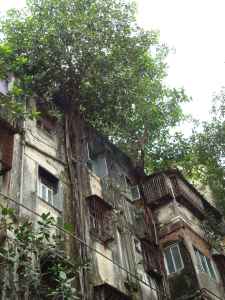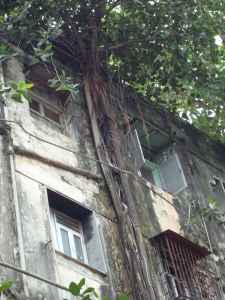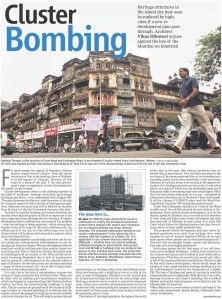My latest assignment takes me to the Kalbadevi area of Mumbai. Amongst the oldest areas of the city, it could be more than two centuries old. The area was originally the only commercial business district of the city and in spite of the city growing far more in all directions and with much more business districts it still retains its status as the prima donna of trading areas. It is the bastion of members of India’s most prominent trading communities, the Gujarati’s, Marwari’s, Punjabi’s, Sindhi’s and the Jain’s.
The area (even Kalbadevi’s immediate neighbourhoods) does thousands of crores worth of turnover daily in almost every conceivable material and commodity that the country produces, exports or imports.
My assignment is about a project looking into how the area can be systematically redeveloped as per a Master Plan. My role is to engage the community in the area so to understand their views and demands from the redevelopment exercise. Besides, my key area of interest remains environmental sustainability and the project has an interest in incorporating best practices, such that the environmental impact of the new planned development is minimal.
I have a historic connect with the area since my father was born and lived most of his youth a little away from where my site office is. I too would have been born in the area but thankfully wasn’t. As a kid in the 1980’s I would visit this area during vacations or odd times and would be pretty disgusted with the crowds, the dirt, the strained urban nature and complete lack of any civic sense amongst most of the residents of the area. And to top it there would be a certain sense of pride and arrogance in the way they lived – just because they live in Kalbadevi and South Mumbai. I would wish death to most of the people then, and a great fire to the area. None happened and the area is as dirty and the people as incapable of finding a solution for their area. Though my father passed away last year.
My father was every bit the solution finder and imaginative about urban issues as I am except that all he wanted to do was to show his knowledge and impress his ideas upon people. He was no different from the average Kalbadevi-ite in being able to take initiative (at least on such issues).
When I compare my childhood memories then I feel the area has certainly improved in its civic sense and cleanliness a lot. Then I would see these really vicious people whom you couldn’t say a thing if they threw waste from their windows on the street. Or the streets were much dirtier and littering more prevalent then. I think globalisation and the exposure to the world (through TV for most) has made the area cleaner.
Now as I spend ‘quality time’ in the area (almost 12 hours a day at times) in the area I cannot once again but observe in detail the people of the area, their behaviour, their thought patterns, their levels of civility, their imagination levels and their display (or lack of it) of those more elevated levels of behaviour that humanity fervently chases.
The area is pre dominatly Hindu and Jain and I get intrigued about the role of religion and culture in the current state of the area. I live further north of the area in the suburbs in a building which has a compound space where cars can be parked and kids can play. On one side of my building there is a 5 acre garden and immediately facing my 3rd floor balcony is a small garden with palm trees. As I write this sitting in my balcony I think about how contrary the atmosphere is in Kalbadevi.
Kalbadevi reeks of sewage and rotting garbage as they mix in narrow gaps between two buildings called house gullies. These house gullies are areas where the sewage and water pipelines for the buildings pass through. Some of the individual tenements of the buildings find themselves with one window besides the house gully and people do not think twice before throwing garbage into these. Over time the garbage mixes with sewage leaking from decades old pipes and the combination stinks only to be cleaned by the Municipal authorities once in a while. Rats find it a very convenient home.
The people live in dingy buildings with dark and foreboding staircases. Most buildings are supported with stilts and other props which keep them from falling. Most people live in 200-400 sq. feet tenements and share common toilets. An average of 4-5 people live in tenements of this size. For most people at least a generation or two has lived like this. I wonder what kind of lives these people must be living in these units.
Businessmen have over the years carried out their trading from such places and become multimillionaires able to afford posh flats close by and travel all over the world. But the wealth has had no impact in their attitudes towards their neighbourhood.
The area doesn’t have any open spaces and playgrounds. Children play gully cricket on Sundays or sometimes go to Azad Maidan and other grounds a little bit away. While a century back most of the commercial and economic activity was limited to some of the well defined markets in the past few decades a number of the residential tenements in buildings have been converted to various commercial usages including storage of cotton yarn and other products. Labour and business visitors throng the area during the day.
When we come up with the idea of a planned redevelopment of the area I wonder how these people have anyways lived like this all these years. What kind of a culture do these people belong to which allows people to live in these kind of conditions for decades without finding solutions? Is it the same culture which proudly talks of the Mohenjo Daro civilisations, which provided for exemplary levels of drainage 5000 years back.
I have for long been a vocal critic of the jingoism that passes of for Indian culture and Hinduism and its supposed greatness over western culture and other cultures. And in Kalbadevi that supposed greatness gets not only questioned but also cremated. When a culture and people get so busy to get into one upmanship and petty rivalry and arrogance at the cost of even not being able to live in clean and decent surroundings then there is not an iota of greatness in that culture.
The jingoists present India and Hinduism as the one stop shop for solutions to all the problems of the world. We gave the world the zero, which in itself is such an over riding contribution, that the world just need not doubt us about our ability and ask for anymore proof. But still the benign and generous and most intelligent people that we are we can give you the yoga and Ayurveda to take care of all your health problems. Our intelligent techies run the wheels of the world. Our culture is unparalleled and we are a country which respects it elders and where the family is most sacrosanct unlike the defiled West. Number of half truths and unchallenged statements.
Kalbadevi is full of super religious Hindus. I consider myself a rational Hindu – considering the Gods to my friends whom I say hi and bye to and whose counsel I seek in times of need. The Hindus of Kalbadevi are different. They are a bit too much into their gods and temples and rituals and a bit too less in loving their fellow beings. They are vicious lot who like the quote goes “mooh pe ram aur bagal mein choori” can never be trusted with what ill they may have in their minds for their fellow residents.
And when I hear of the same people talking of the problems like the Amarnath yatra and the damage Muslims are doing etc. I wonder what is stopping them from doing some good for their own selves in their own secure bastion? The Muslims or other imagined enemies are not responsible for the ridiculously bad living conditions in which these people live in a completely Hindu area. For all the talk of benevolence neither the tenants or the landlords display any of the characteristics which the thousands of spiritual gurus – which the area follows cultivates – propound. Members of castes and sects, and sub castes and sub sects are so wedded to their narrow community and dogmatic that they will not cooperate with another Hindu also.
I think it is these characteristics – which too me somewhere have become representative of Hindus- which are turning out to be the biggest enemy of Hinduism.
I cant help splitting up when I hear people talk of making the temple at Ayodhya and collecting funds for the yatra and other such things. If Ram was around he wouldn’t have come to so much as even shit in this area. If one were to believe that God exists everywhere then the wealthy and not so wealthy of Kalbadevi need to first do something about the squalor they have reduced their temple to, with absolutely no help from Babar or his tribe.


